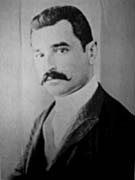
Américo Bonetti was born within a Swiss family, on June 8, 1865. He practises the art of engraving and sculpturing at his father’s cabinet-making workshop, and in time studies basic techniques with Francisco Parodi.
A contemporary of Argentine sculptors Lucio Correa Morales and Francisco Cafferata, he develops his work mainly at the La Boca neighborhood but eventually moves to the north of the country, where he carves wooden animals and typical characters of that area. Upon his return, he makes religious sculptors of which images of Christ and Saint John stand out. These were placed at the San Pedro church (St. Peter’s church) and San Juan Evangelista (St. John Evangelist) respectively, both in La Boca.
José León Pagano points out that when Francisco Cafferata dies, in 1890, Bonetti “[...] he is forced to concentrate on decorative art, a bit vague at the time [...]” for at that moment, all of the national sculpturing scene evolved around one single name, that of Correa Morales as “[...] there was no other Argentine artist who could represent our criollo art [...].”
Today, at the show room that bears his name at the Museo de Bellas Artes de La Boca, we can find eighteen figureheads rescued by Quinquela from the old shipyard wrecks. Two of them belong to Bonetti and have recently been restored. They are: El ángel de la trompeta (The angel with a trumpet) (1889) and Pailebot Greca Latina (1887), both made of polychrome wood exhibited in an atmosphere that simulates a marine space, between acrylic panels and fish tanks.
Américo Bonetti dies in Quilmes, Buenos Aires, on October 6, 1931.